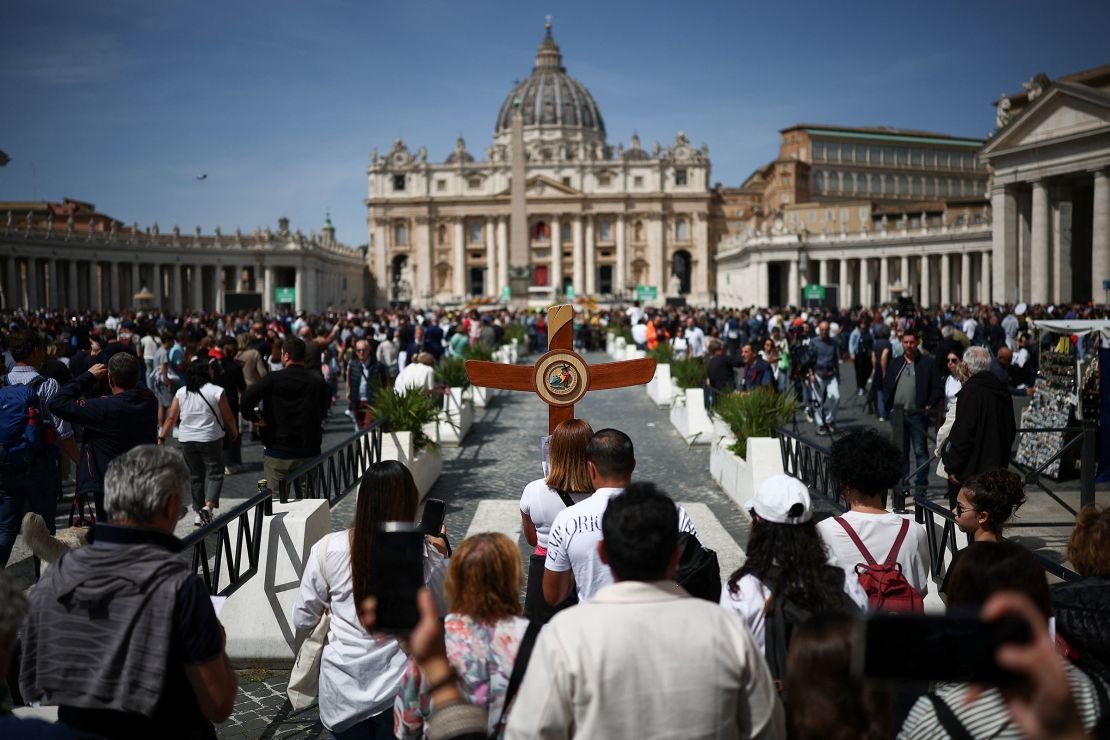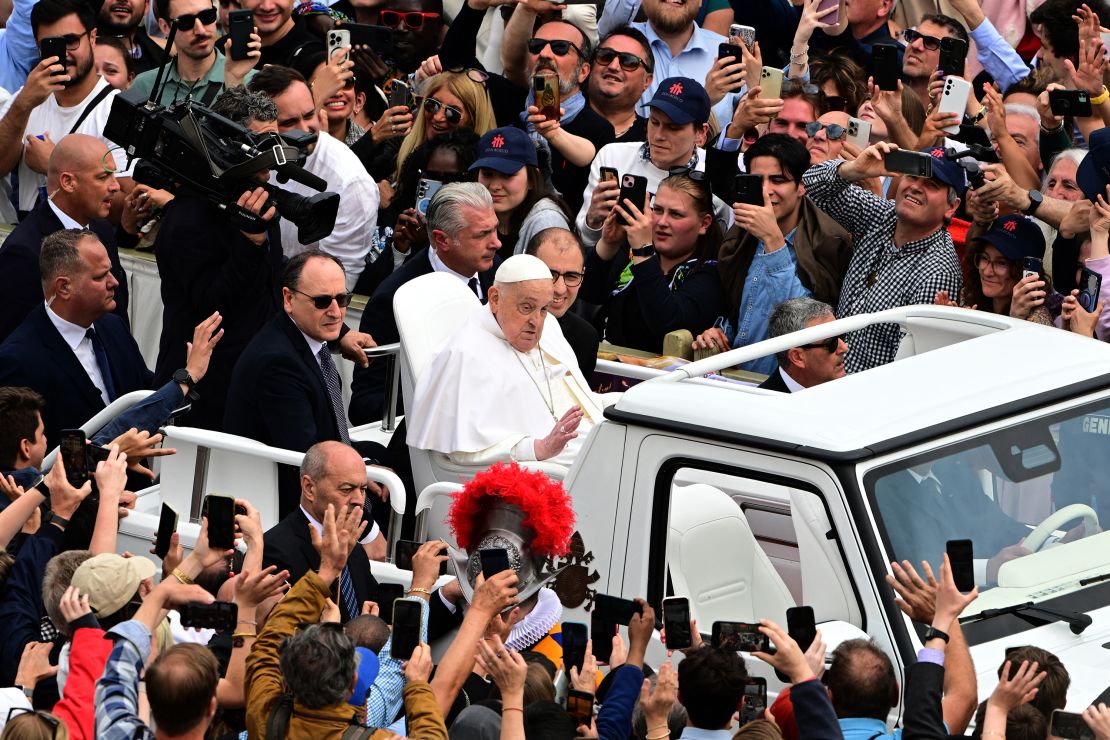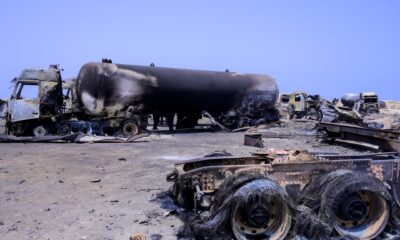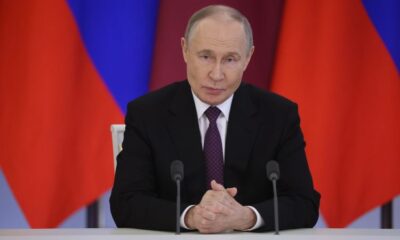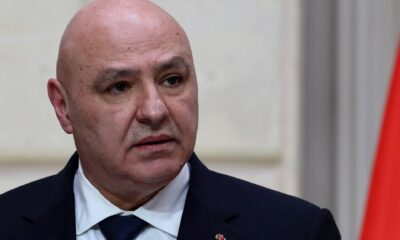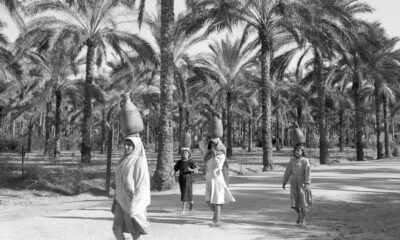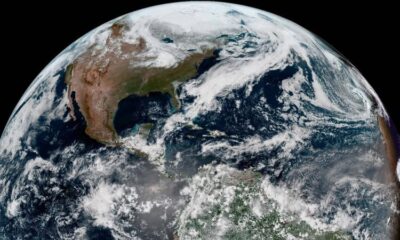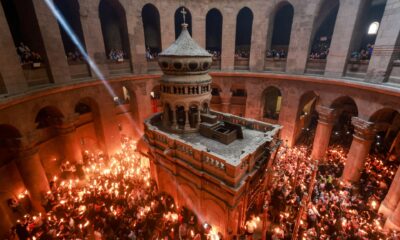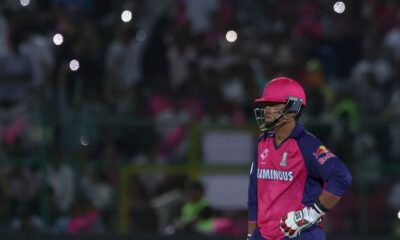CNN
—
When the newly elected Pope Francis returned to the front desk of his hotel in Rome to personally settle his bill a day after being introduced to cheering crowds in St. Peter’s Square in 2013, it was a first glimpse into the modesty that would come to define his papacy.
But for one real estate developer turned reality television star observing developments from his penthouse in Manhattan, it was a sign of something else.
“I don’t like seeing the Pope standing at the checkout counter (front desk) of a hotel in order to pay his bill,” Donald Trump, still years from mounting his first presidential bid, wrote on Twitter. “It’s not Pope-like!”
There was little in common between now-President Trump and Pope Francis, who died Monday at 88. The two men sparred from afar on issues of immigration and the environment, adopted divergent approaches to the sumptuous trappings of their respective offices, and lived vastly different kinds of lives.
“That’s why I’ll never be Pope!” Trump responded to a commenter on his post in 2013, who observed “the difference between the Pope and you is the Pope doesn’t have to constantly brag how great he is.”
Yet for all the obvious differences, there was some overlap in how Francis and Trump arrived at their positions, and how they viewed their roles.
Each was elected as an outsider and brought to their office a pledge to represent society’s forgotten: for Trump, the American workers who he said Washington passed over in an era of globalization; and for Francis, the poor and marginalized often left to the side of a fast-changing world.
Both also sought dramatic changes to the institutions they ran: the sprawling federal government for Trump, and the billion-person strong Catholic Church for Francis.
“He’s a very good man who loved the world. And he especially loved people that were having a hard time. And that’s good with me,” Trump said Monday after ordering flags on federal buildings lowered to half staff.
Trump sent his love to American Catholics before quickly turning his remarks toward his strength among Catholic voters.
“We love you all, we’re with you all. They were with me through the election, as you know, very strongly,” Trump said at the annual White House Easter Egg Roll. “It’s just an honor to have the support of the Catholics. I feel very badly for them because they love the pope.”
When they met during Trump’s first term at the Vatican in 2017 — their only face-to-face encounter — Trump and Francis had already been tangling on the issue of immigration after Francis declared anyone who builds a wall to keep out migrants was “not a Christian.” Trump had spent the 2016 presidential campaign vowing to construct a wall along the Southern US border to keep migrants out.
Those differences were put aside during Trump’s visit, where he was accompanied by his wife Melania, who wore a traditional black veil. Both leaders appeared determined not to let their dispute spoil the encounter.
And like most presidents before him, Trump emerged from his meeting with the pope appearing starstruck.
“He is something, he’s really good. We had a fantastic meeting and we had a fantastic tour, it was really beautiful,” Trump said.
Trump and the first lady had arrived to the Vatican about a half-hour earlier, his long motorcade and armored black SUV a stark contrast to the blue Ford Focus that Francis himself had arrived in to work that day.
The meeting was not entirely devoid of politics. The pope presented Trump a copy of his influential encyclical document on preserving the environment, which was interpreted as an attempt by Francis to encourage Trump to adopt stronger efforts at combatting climate change. (It didn’t appear effective; Trump withdrew from the Paris climate accord a few weeks later).
Like many world leaders who watch Trump from afar, Francis found Trump easier to talk to than his harsh language on the campaign trail might have suggested.
He lightened the mood when shaking Melania Trump’s hand, asking her in Italian, “Did you give him potica to eat?” — referring to the Slovenian dessert few could imagine the glamorous former model whipping up in the White House kitchen.
Francis also handed Trump a medallion etched with the image of an olive tree, which he explained was “a symbol of peace.”
“We can use peace,” Trump responded. As they parted ways, Trump told him: “I won’t forget what you said.”
Influential meetings with Obama and Biden
The three US presidents who met Francis all found themselves moved by the experience in different ways. President Barack Obama took the rare step of traveling to Joint Base Andrews to greet Francis at the start of the pope’s blockbuster visit to the United States in 2015.
Later, the pope led a short parade in his open-air popemobile around the South Lawn, which was crowded with thousands who had come to witness a rare papal visit to the White House, some carrying babies for the pope to kiss.
The cultural moment couldn’t be denied several months later on Halloween, when the child of an administration official arrived to the annual White House trick-or-treating event dressed as the pontiff, complete with a tiny white car.
It was on that visit that Francis met privately with members of then-Vice President Joe Biden’s family in the immediate aftermath of his son Beau Biden’s death from cancer. Counseling the Biden’s inside an airplane hanger at the Philadelphia International Airport, Francis “provided us with more comfort that even he, I think, will understand,” Biden would later recount.
After he became president, Biden traveled to Rome amid a raging debate inside the US Catholic Church over whether he and other politicians who support abortion rights should receive communion. Afterward, Biden said Francis called him a “good Catholic” and that he should continue receiving the sacrament.
Last year, as he was preparing to depart office under a cloud of disappointment following his exit from the 2024 race and his vice president’s loss to Trump, Biden had planned to visit Rome again to meet Francis. The trip was canceled amid wildfires in Los Angeles, but in his final days as president Biden awarded Francis the nation’s highest civilian honor, the Presidential Medal of Freedom.
Trump and Francis would never meet again after their 2017 encounter. After Trump was elected to a second term, Francis took harsh aim at his administration’s plans for mass deportations, warning such a step would deprive migrants of their inherent dignity and “will end badly.”
It was a remarkable rebuke, issued in a letter to US bishops. It appeared to take aim at Vice President JD Vance for his defense of deportations on theological grounds.
“Christian love is not a concentric expansion of interests that little by little extend to other persons and groups,” the pope wrote, responding to Vance’s assertion that people should take care of their family, communities and country before expanding care to others.
In some ways, the rupture appeared to reflect a growing rift between traditionalist American Catholics and the Vatican under Francis, which had sought to be more inclusive of same-sex couples, women and other groups.
Still, the discord did not appear to seep into Vance’s meeting with Francis on Easter Sunday, just a day before he died. Vance appears to have been the last world leader Francis met before his death. He sat briefly with the pope in a reception room at the Casa Santa Marta, the Vatican guesthouse where he has lived since his election in 2013.
Vance, who has called himself a “baby Catholic” after converting to the faith as an adult, was on Vatican grounds on Sunday for less than 20 minutes, and the meeting hadn’t been confirmed ahead of time. During their short session, the pope gifted the vice president a tie, rosaries and three big chocolate Easter eggs for Vance’s three children.
“I pray for you every day,” Vance could be heard telling the Pontiff as they sat together at the Vatican.
This story has been updated with Trump’s remarks on Monday.

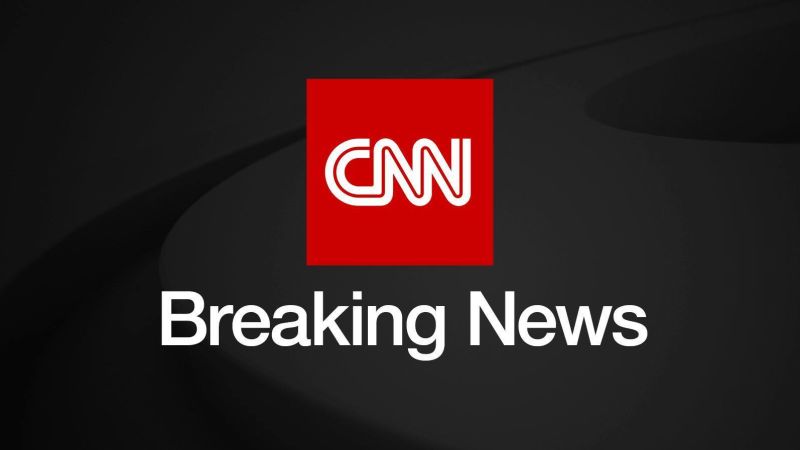
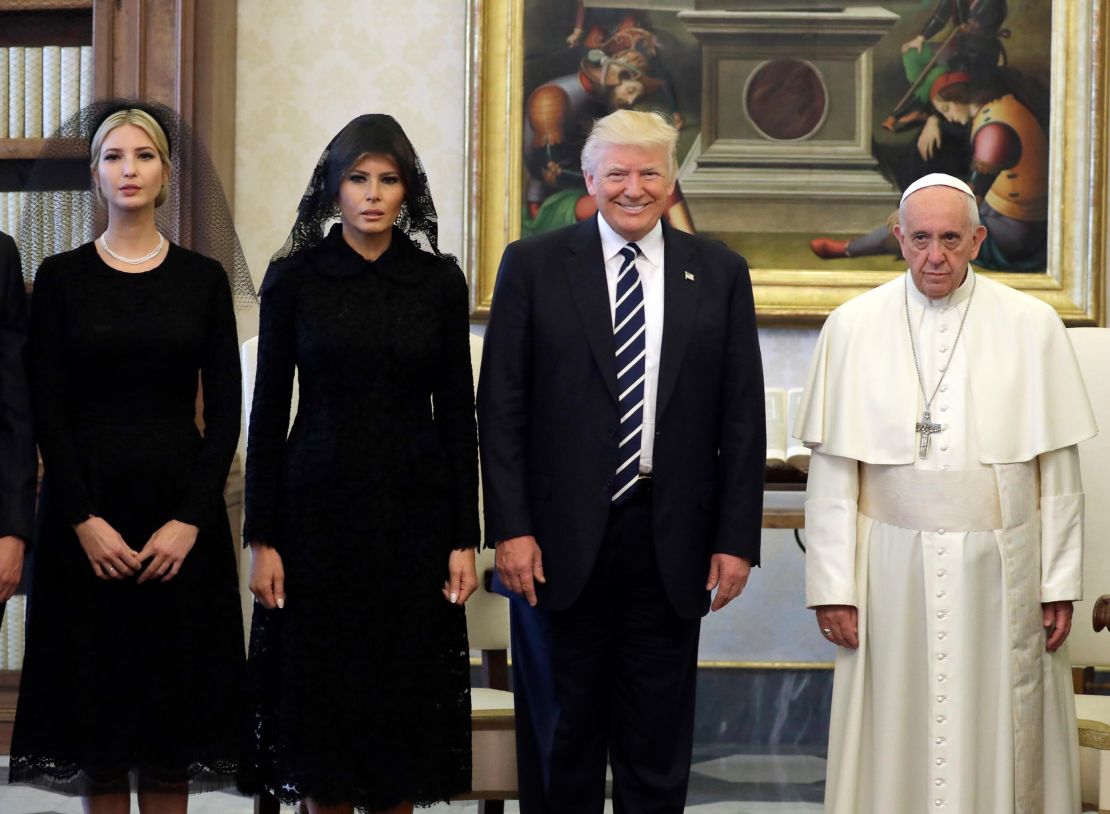

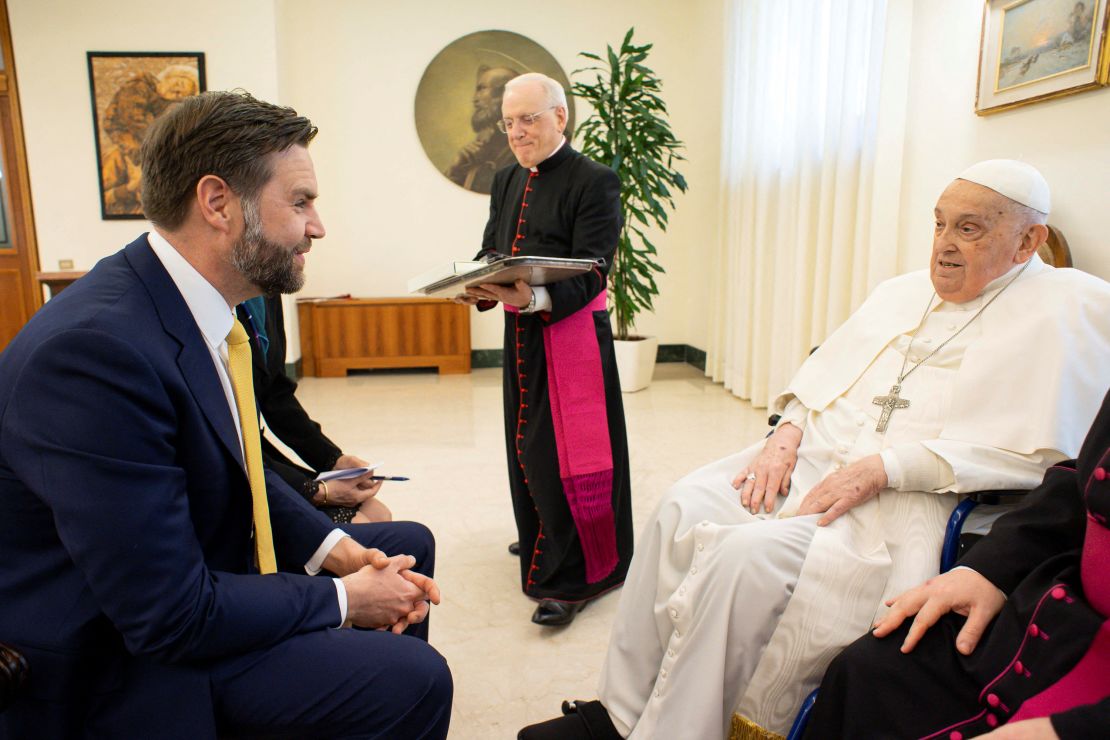
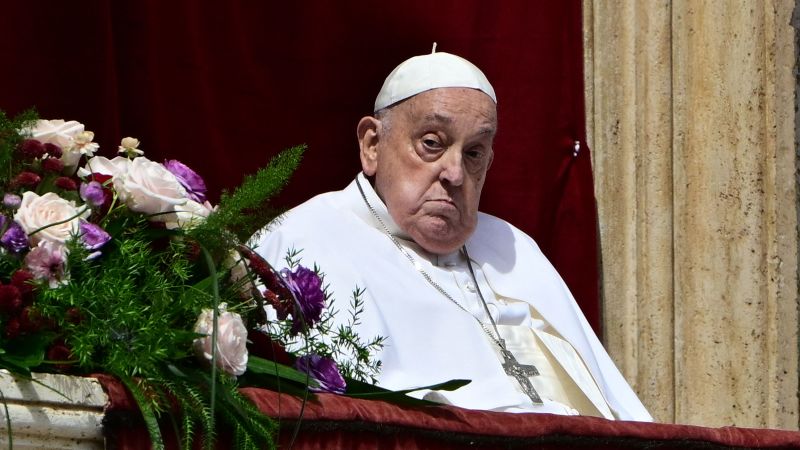

































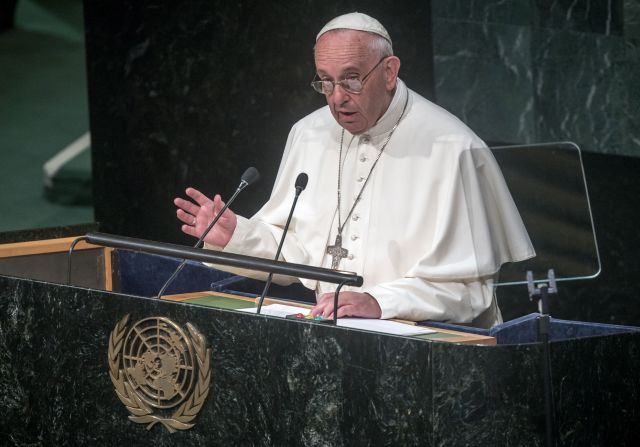 his speech, he urged world leaders to adopt concrete solutions to combat widespread poverty and environmental destruction.” class=”image__dam-img image__dam-img–loading” onload=’this.classList.remove(‘image__dam-img–loading’)’ onerror=”imageLoadError(this)” height=”2095″ width=”3000″ loading=’lazy’/>
his speech, he urged world leaders to adopt concrete solutions to combat widespread poverty and environmental destruction.” class=”image__dam-img image__dam-img–loading” onload=’this.classList.remove(‘image__dam-img–loading’)’ onerror=”imageLoadError(this)” height=”2095″ width=”3000″ loading=’lazy’/>





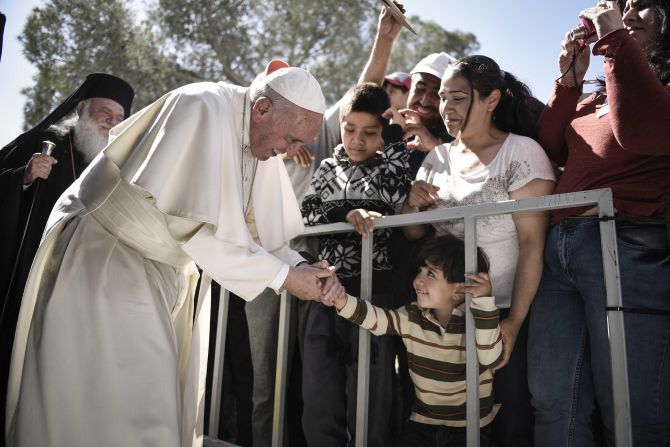 during a visit in which he showed solidarity with migrants fleeing war and poverty. ” class=”image__dam-img image__dam-img–loading” onload=’this.classList.remove(‘image__dam-img–loading’)’ onerror=”imageLoadError(this)” height=”1669″ width=”2500″ loading=’lazy’/>
during a visit in which he showed solidarity with migrants fleeing war and poverty. ” class=”image__dam-img image__dam-img–loading” onload=’this.classList.remove(‘image__dam-img–loading’)’ onerror=”imageLoadError(this)” height=”1669″ width=”2500″ loading=’lazy’/>
 was there to pay tribute to those who died in the Holocaust. ” class=”image__dam-img image__dam-img–loading” onload=’this.classList.remove(‘image__dam-img–loading’)’ onerror=”imageLoadError(this)” height=”1664″ width=”2500″ loading=’lazy’/>
was there to pay tribute to those who died in the Holocaust. ” class=”image__dam-img image__dam-img–loading” onload=’this.classList.remove(‘image__dam-img–loading’)’ onerror=”imageLoadError(this)” height=”1664″ width=”2500″ loading=’lazy’/>




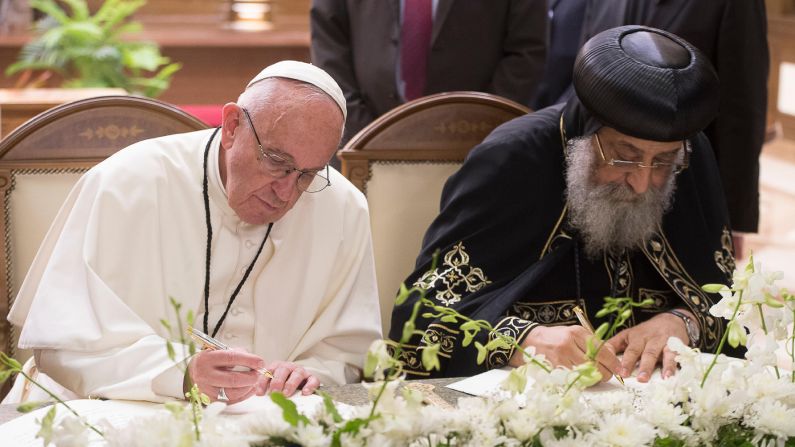 two-day trip to Egypt to forge Muslim-Christian brotherhood and show solidarity with the country’s persecuted Coptic Christian minority.” class=”image__dam-img image__dam-img–loading” onload=’this.classList.remove(‘image__dam-img–loading’)’ onerror=”imageLoadError(this)” height=”1569″ width=”2790″ loading=’lazy’/>
two-day trip to Egypt to forge Muslim-Christian brotherhood and show solidarity with the country’s persecuted Coptic Christian minority.” class=”image__dam-img image__dam-img–loading” onload=’this.classList.remove(‘image__dam-img–loading’)’ onerror=”imageLoadError(this)” height=”1569″ width=”2790″ loading=’lazy’/>
 private audience at the Vatican in May 2017. Joining the President are his wife, Melania, and his daughter Ivanka.” class=”image__dam-img image__dam-img–loading” onload=’this.classList.remove(‘image__dam-img–loading’)’ onerror=”imageLoadError(this)” height=”2966″ width=”5272″ loading=’lazy’/>
private audience at the Vatican in May 2017. Joining the President are his wife, Melania, and his daughter Ivanka.” class=”image__dam-img image__dam-img–loading” onload=’this.classList.remove(‘image__dam-img–loading’)’ onerror=”imageLoadError(this)” height=”2966″ width=”5272″ loading=’lazy’/>







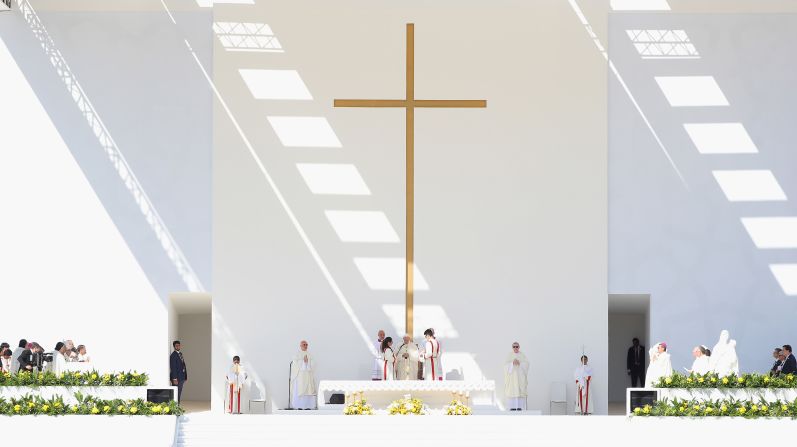 the first time a pope has visited an Arab Gulf state, and it was the first time a pope had celebrated Mass in the Arabian Peninsula, the birthplace of Islam.” class=”image__dam-img image__dam-img–loading” onload=’this.classList.remove(‘image__dam-img–loading’)’ onerror=”imageLoadError(this)” height=”1403″ width=”2500″ loading=’lazy’/>
the first time a pope has visited an Arab Gulf state, and it was the first time a pope had celebrated Mass in the Arabian Peninsula, the birthplace of Islam.” class=”image__dam-img image__dam-img–loading” onload=’this.classList.remove(‘image__dam-img–loading’)’ onerror=”imageLoadError(this)” height=”1403″ width=”2500″ loading=’lazy’/>




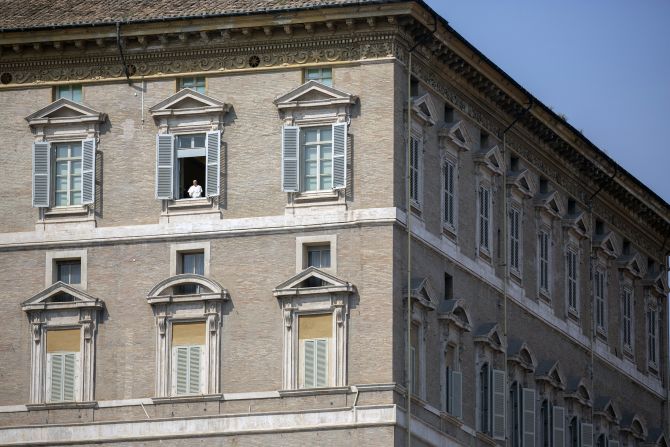 his weekly blessing from the window of his private library in March 2020. St. Peter’s Square is normally swarming with tens of thousands of visitors, but the Vatican was on lockdown because of the coronavirus pandemic.” class=”image__dam-img image__dam-img–loading” onload=’this.classList.remove(‘image__dam-img–loading’)’ onerror=”imageLoadError(this)” height=”1667″ width=”2500″ loading=’lazy’/>
his weekly blessing from the window of his private library in March 2020. St. Peter’s Square is normally swarming with tens of thousands of visitors, but the Vatican was on lockdown because of the coronavirus pandemic.” class=”image__dam-img image__dam-img–loading” onload=’this.classList.remove(‘image__dam-img–loading’)’ onerror=”imageLoadError(this)” height=”1667″ width=”2500″ loading=’lazy’/>

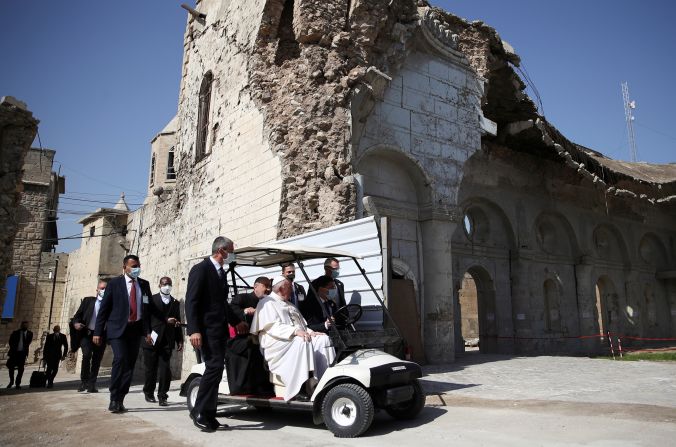 the first-ever papal visit to Iraq, and it was Francis’ first trip outside Italy since the start of the Covid-19 pandemic.” class=”image__dam-img image__dam-img–loading” onload=’this.classList.remove(‘image__dam-img–loading’)’ onerror=”imageLoadError(this)” height=”1654″ width=”2500″ loading=’lazy’/>
the first-ever papal visit to Iraq, and it was Francis’ first trip outside Italy since the start of the Covid-19 pandemic.” class=”image__dam-img image__dam-img–loading” onload=’this.classList.remove(‘image__dam-img–loading’)’ onerror=”imageLoadError(this)” height=”1654″ width=”2500″ loading=’lazy’/>

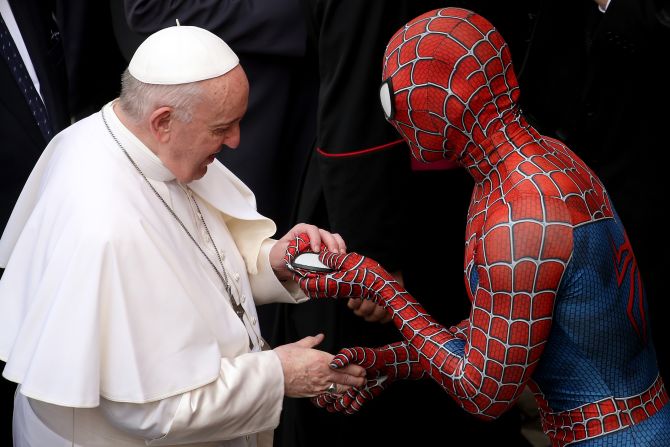 shakes hands with a man dressed as Spider-Man while visiting with people at the Vatican in June 2021. The masked man, who works with sick children in hospitals, also gave a Spider-Man mask to the Pope.” class=”image__dam-img image__dam-img–loading” onload=’this.classList.remove(‘image__dam-img–loading’)’ onerror=”imageLoadError(this)” height=”1667″ width=”2500″ loading=’lazy’/>
shakes hands with a man dressed as Spider-Man while visiting with people at the Vatican in June 2021. The masked man, who works with sick children in hospitals, also gave a Spider-Man mask to the Pope.” class=”image__dam-img image__dam-img–loading” onload=’this.classList.remove(‘image__dam-img–loading’)’ onerror=”imageLoadError(this)” height=”1667″ width=”2500″ loading=’lazy’/>

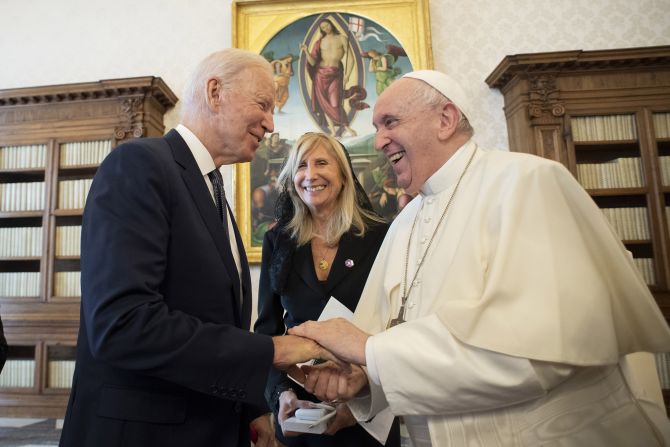 his trip to the Vatican in October 2021. Between them is Italian translator Elisabetta Savigni Ullmann. Challenge coins originated in the military, and this one included the insignia of a Delaware Army National Guard unit that Biden’s son Beau served in. Biden said during his visit that coins are given to “warriors and leaders” and that the pope is “the most significant warrior for peace I’ve ever met.” Biden, a devout lifelong Catholic, met with the Pope for 90 minutes and said he discussed “a lot of personal things” with the pontiff. It was the fourth meeting between Francis and Biden, but their first since Biden became President.” class=”image__dam-img image__dam-img–loading” onload=’this.classList.remove(‘image__dam-img–loading’)’ onerror=”imageLoadError(this)” height=”1667″ width=”2500″ loading=’lazy’/>
his trip to the Vatican in October 2021. Between them is Italian translator Elisabetta Savigni Ullmann. Challenge coins originated in the military, and this one included the insignia of a Delaware Army National Guard unit that Biden’s son Beau served in. Biden said during his visit that coins are given to “warriors and leaders” and that the pope is “the most significant warrior for peace I’ve ever met.” Biden, a devout lifelong Catholic, met with the Pope for 90 minutes and said he discussed “a lot of personal things” with the pontiff. It was the fourth meeting between Francis and Biden, but their first since Biden became President.” class=”image__dam-img image__dam-img–loading” onload=’this.classList.remove(‘image__dam-img–loading’)’ onerror=”imageLoadError(this)” height=”1667″ width=”2500″ loading=’lazy’/>



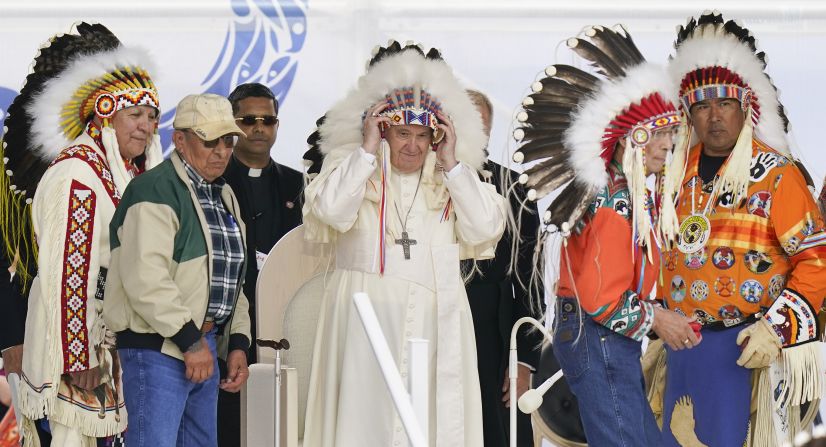 Francis spoke of his “sorrow, indignation and shame” over the Catholic Church’s role in the abuse of Canadian Indigenous children in residential schools. He apologized and promised a “serious investigation” into what happened.” class=”image__dam-img image__dam-img–loading” onload=’this.classList.remove(‘image__dam-img–loading’)’ onerror=”imageLoadError(this)” height=”1973″ width=”3646″ loading=’lazy’/>
Francis spoke of his “sorrow, indignation and shame” over the Catholic Church’s role in the abuse of Canadian Indigenous children in residential schools. He apologized and promised a “serious investigation” into what happened.” class=”image__dam-img image__dam-img–loading” onload=’this.classList.remove(‘image__dam-img–loading’)’ onerror=”imageLoadError(this)” height=”1973″ width=”3646″ loading=’lazy’/>

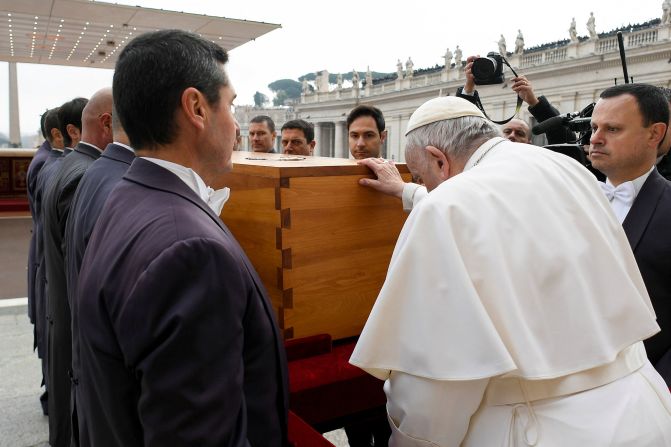 Benedict’s funeral was attended by tens of thousands at St. Peter’s Square.” class=”image__dam-img image__dam-img–loading” onload=’this.classList.remove(‘image__dam-img–loading’)’ onerror=”imageLoadError(this)” height=”2000″ width=”3000″ loading=’lazy’/>
Benedict’s funeral was attended by tens of thousands at St. Peter’s Square.” class=”image__dam-img image__dam-img–loading” onload=’this.classList.remove(‘image__dam-img–loading’)’ onerror=”imageLoadError(this)” height=”2000″ width=”3000″ loading=’lazy’/>
 Francis’ visit to the DRC — the first papal visit since 1985 — was part of a six-day trip that also included South Sudan. In those two countries, Catholics comprise about half of the population and the Church is a key stakeholder in health and education systems as well as in democracy-building efforts. ” class=”image__dam-img image__dam-img–loading” onload=’this.classList.remove(‘image__dam-img–loading’)’ onerror=”imageLoadError(this)” height=”1334″ width=”2000″ loading=’lazy’/>
Francis’ visit to the DRC — the first papal visit since 1985 — was part of a six-day trip that also included South Sudan. In those two countries, Catholics comprise about half of the population and the Church is a key stakeholder in health and education systems as well as in democracy-building efforts. ” class=”image__dam-img image__dam-img–loading” onload=’this.classList.remove(‘image__dam-img–loading’)’ onerror=”imageLoadError(this)” height=”1334″ width=”2000″ loading=’lazy’/>



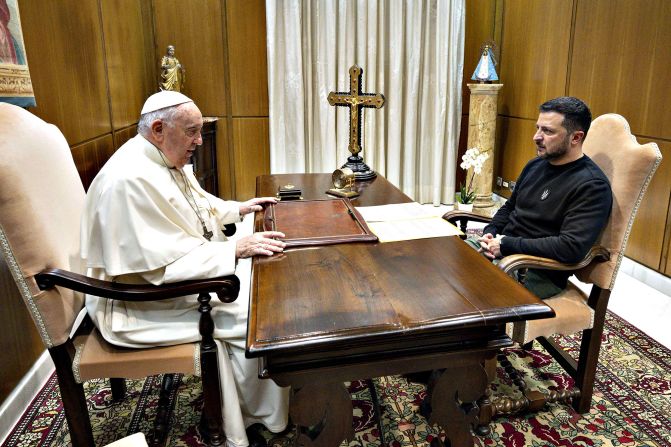 meets with Ukrainian President Volodymyr Zelensky at the Vatican in May 2023. It was the first face-to-face meeting between Zelensky and the Pope since Russia invaded Ukraine in February 2022. The Pope has been outspoken in his support for an end to the war.” class=”image__dam-img image__dam-img–loading” onload=’this.classList.remove(‘image__dam-img–loading’)’ onerror=”imageLoadError(this)” height=”1333″ width=”2000″ loading=’lazy’/>
meets with Ukrainian President Volodymyr Zelensky at the Vatican in May 2023. It was the first face-to-face meeting between Zelensky and the Pope since Russia invaded Ukraine in February 2022. The Pope has been outspoken in his support for an end to the war.” class=”image__dam-img image__dam-img–loading” onload=’this.classList.remove(‘image__dam-img–loading’)’ onerror=”imageLoadError(this)” height=”1333″ width=”2000″ loading=’lazy’/>
 He was on his way to a Rome hospital for abdominal surgery. The procedure was to repair a hernia that the Vatican said was causing “recurrent, painful and worsening” symptoms.” class=”image__dam-img image__dam-img–loading” onload=’this.classList.remove(‘image__dam-img–loading’)’ onerror=”imageLoadError(this)” height=”1333″ width=”2000″ loading=’lazy’/>
He was on his way to a Rome hospital for abdominal surgery. The procedure was to repair a hernia that the Vatican said was causing “recurrent, painful and worsening” symptoms.” class=”image__dam-img image__dam-img–loading” onload=’this.classList.remove(‘image__dam-img–loading’)’ onerror=”imageLoadError(this)” height=”1333″ width=”2000″ loading=’lazy’/>






 working session on artificial intelligence during the G7 summit near Bari, Italy, in June 2024. Francis, the first pope to participate in the summit, is determined to use the soft power of his office to try to ensure that the development of AI serves humanity and does not turn into a 21st-century Frankenstein’s monster.” class=”image__dam-img image__dam-img–loading” onload=’this.classList.remove(‘image__dam-img–loading’)’ onerror=”imageLoadError(this)” height=”1667″ width=”2500″ loading=’lazy’/>
working session on artificial intelligence during the G7 summit near Bari, Italy, in June 2024. Francis, the first pope to participate in the summit, is determined to use the soft power of his office to try to ensure that the development of AI serves humanity and does not turn into a 21st-century Frankenstein’s monster.” class=”image__dam-img image__dam-img–loading” onload=’this.classList.remove(‘image__dam-img–loading’)’ onerror=”imageLoadError(this)” height=”1667″ width=”2500″ loading=’lazy’/>


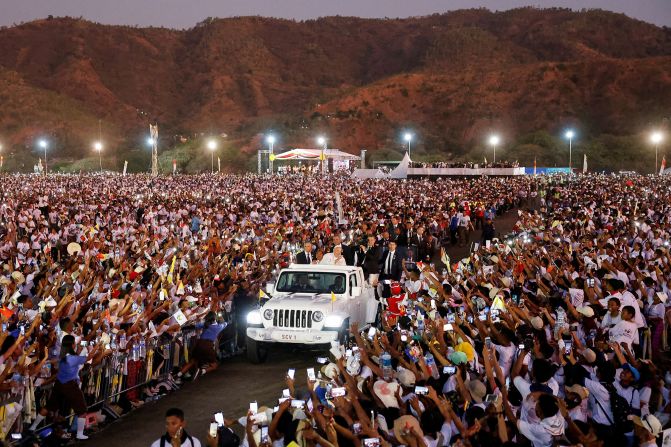 leading a Holy Mass at the Esplanade of Tasi Tolu in Dili, East Timor, on September 10, 2024.
leading a Holy Mass at the Esplanade of Tasi Tolu in Dili, East Timor, on September 10, 2024.


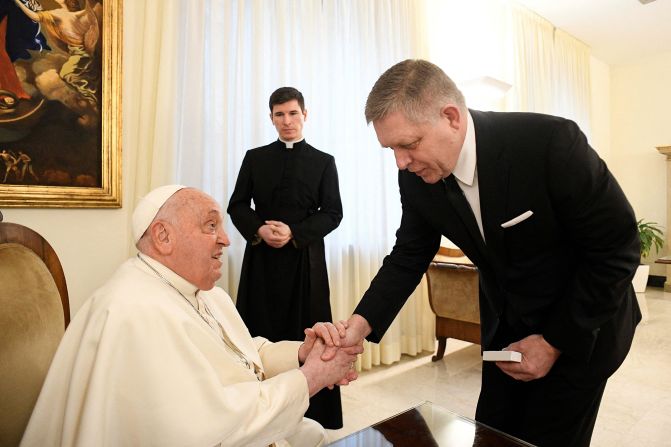 the Pope was admitted to a hospital in Rome. It was later announced that he was battling pneumonia in both of his lungs.” class=”image__dam-img image__dam-img–loading” onload=’this.classList.remove(‘image__dam-img–loading’)’ onerror=”imageLoadError(this)” height=”1333″ width=”2000″ loading=’lazy’/>
the Pope was admitted to a hospital in Rome. It was later announced that he was battling pneumonia in both of his lungs.” class=”image__dam-img image__dam-img–loading” onload=’this.classList.remove(‘image__dam-img–loading’)’ onerror=”imageLoadError(this)” height=”1333″ width=”2000″ loading=’lazy’/>

 he was discharged from the Gemelli Hospital in Rome in March 2025. Though he looked frail and struggled to speak, he addressed the crowd outside the hospital, thanking them and acknowledging one woman in the crowd who was holding flowers. He also gave a blessing, though he appeared to have some difficulty raising his arms.” class=”image__dam-img image__dam-img–loading” onload=’this.classList.remove(‘image__dam-img–loading’)’ onerror=”imageLoadError(this)” height=”1242″ width=”2000″ loading=’lazy’/>
he was discharged from the Gemelli Hospital in Rome in March 2025. Though he looked frail and struggled to speak, he addressed the crowd outside the hospital, thanking them and acknowledging one woman in the crowd who was holding flowers. He also gave a blessing, though he appeared to have some difficulty raising his arms.” class=”image__dam-img image__dam-img–loading” onload=’this.classList.remove(‘image__dam-img–loading’)’ onerror=”imageLoadError(this)” height=”1242″ width=”2000″ loading=’lazy’/>



